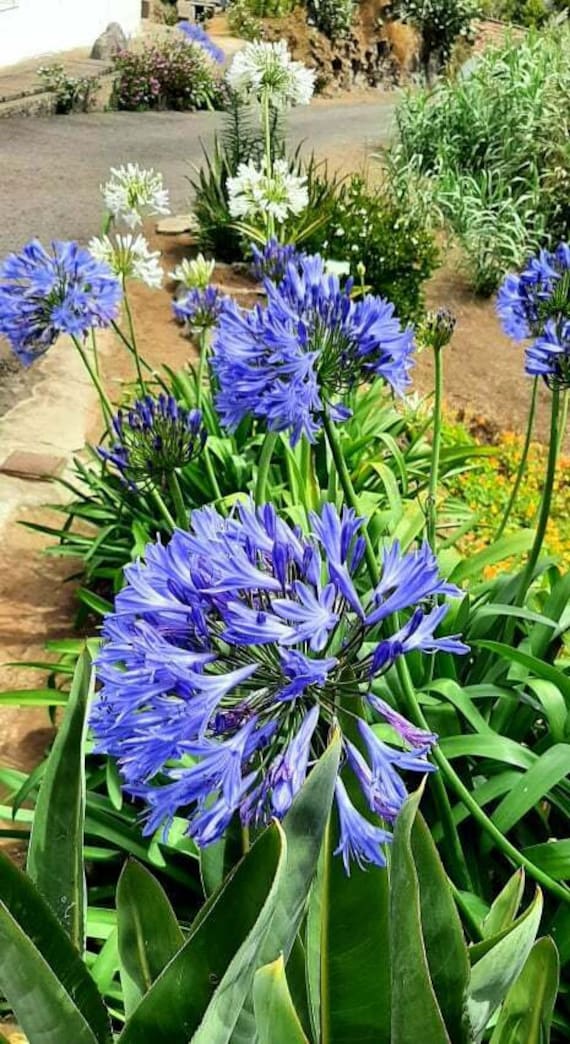Unleashing the Secret to Effective Agapanthus Growing: Idea for a Flourishing Yard
In the world of gardening, cultivating agapanthus effectively needs a calculated method that encompasses numerous aspects of plant care. By recognizing the nuances of agapanthus cultivation, one can develop an atmosphere where these plants thrive and grow generously.
Planting Agapanthus: Ideal Practices
When planting Agapanthus, appropriate soil prep work is vital for guaranteeing effective growth and development of these attractive flowers. Agapanthus, commonly known as Lily of the Nile or African lily, flourishes in well-draining dirt with a slightly acidic to neutral pH degree - Agapanthus. Before growing, it is important to amend hefty clay dirts with organic issue such as compost or peat moss to improve drain and provide crucial nutrients for the plants
To plant Agapanthus, pick a location that gets full sunlight to partial color, as this will promote healthy and balanced development and bountiful blooming. Dig a hole two times the size of the plant's root sphere and put the Agapanthus at the very same deepness it was formerly growing. Carefully backfill the opening with dirt, weighing down strongly to remove any type of air pockets around the origins.
Water the freshly planted Agapanthus completely and remain to maintain the dirt uniformly wet, especially during the plant's active expanding period. Agapanthus. Using a well balanced plant food once a month can better support the plant's growth and blooming. By adhering to these finest techniques for growing Agapanthus, you can develop a stunning screen of these exciting blossoms in your yard
Suitable Soil Conditions for Agapanthus
For optimum growth and blooming success of Agapanthus plants, ensuring the dirt problems are suitable is critical. Agapanthus chooses dirt that is rich in nutrients, so integrating a balanced fertilizer throughout the expanding season can advertise healthy development and vivid flowers.
Watering and Fertilizing Tips
To guarantee healthy development and lively blooms, proper watering and fertilizing methods are crucial for effective Agapanthus farming. Agapanthus plants profit from routine watering, specifically throughout the expanding season. It is recommended to water deeply once a week, ensuring the soil is damp however not soaked. Throughout heat or in pots, more constant watering might be required to avoid the soil from drying entirely.
When it comes to feeding Agapanthus, a well balanced fertilizer with equal parts nitrogen, phosphorus, and potassium can see this be used in the spring to promote healthy and balanced growth and blooming. Slow-release plant foods are excellent for supplying nutrients gradually over an extensive period. Avoid over-fertilizing, as this can bring about extreme vegetation development at the cost of blooms.
In addition, integrating raw material like compost right into the soil can boost nutrient degrees and improve soil structure, assisting in the general health of the Agapanthus plants. By following these watering and feeding ideas, gardeners can guarantee their Agapanthus plants prosper and produce magnificent screens of blossoms.
Pruning and Deadheading Strategies
Proper pruning and deadheading strategies play an essential duty in maintaining the wellness and aesthetic appeals of Agapanthus plants, enhancing the vital methods of watering and feeding for successful farming. Pruning Agapanthus involves eliminating invested flower heads, yellowing or dead fallen leaves, and general shaping of the plant to advertise better growth. Deadheading, the procedure of removing faded blossoms, not just boosts the plant's appearance however additionally motivates more blooming.
When deadheading Agapanthus, it is a good idea to trim off the blossom stem at the base making use of sharp, clean shears. This process reroutes the plant's power from seed manufacturing back right into origin and foliage growth, advertising a much healthier and more robust plant. Routine deadheading can prolong the blooming duration of Agapanthus and avoid self-seeding, which can cause congestion.
In terms of pruning, Agapanthus normally take advantage of a light trim after blossoming to tidy up the plant and encourage fresh development. Cutting down the invested blossom stems and eliminating any type of broken or dead vegetation helps keep the plant's vitality and general look. Nevertheless, it is vital to avoid reducing right into the crown of the plant, as this can deteriorate its health and wellness.

Protecting Agapanthus From Vermins and Diseases
Implementing effective parasite and disease administration strategies is essential to guarding the health and wellness and vitality of Agapanthus plants in farming. One usual insect that influences Agapanthus is the Agapanthus borer, a caterpillar that tunnels right into the plant, triggering damages to the flowers and leaves.
In addition to bugs, Agapanthus are at risk to conditions such as origin rot and fungal fallen leave spots. By staying watchful and dealing with bug and disease concerns without delay, garden enthusiasts browse around here can assist their Agapanthus prosper and prosper.

Final Thought
To conclude, successful cultivation of agapanthus needs proper growing techniques, perfect dirt conditions, appropriate watering and feeding, regular trimming and deadheading, and defense from insects and conditions. By adhering to these tips and techniques, garden enthusiasts can ensure a flourishing garden filled with attractive agapanthus blooms. Agapanthus. Keep in mind to maintain regular care and interest to information to advertise the health and wellness and long life of these spectacular plants
When growing Agapanthus, proper soil prep work is essential for ensuring successful growth and advancement of these attractive flowers.Water the recently grown Agapanthus thoroughly and continue to keep the dirt equally wet, specifically during the plant's active expanding period.For optimal growth and flowering success of Agapanthus plants, guaranteeing the soil conditions are ideal is important. When planting or transplanting Agapanthus, make sure the dirt is well-prepared to supply the needed helpful hints structure for the plants to establish themselves successfully. One common pest that affects Agapanthus is the Agapanthus borer, a caterpillar that tunnels into the plant, causing damages to the fallen leaves and blossoms.